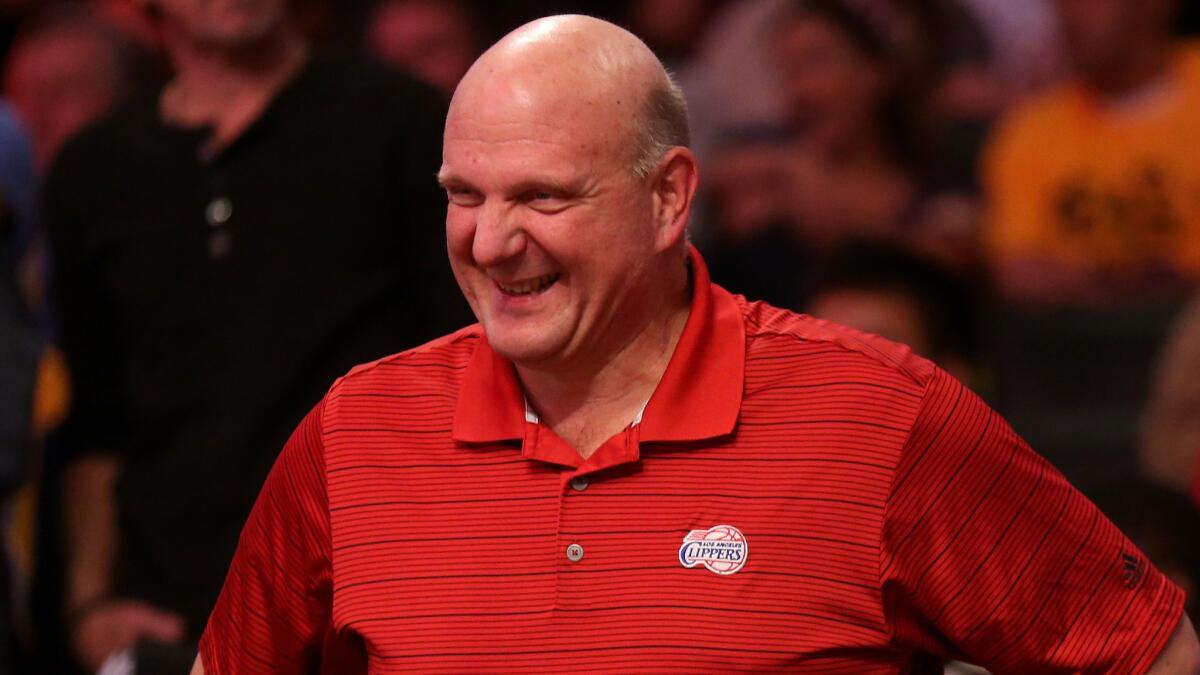Steve Ballmer’s Clippers purchase: Don’t write off tax-break potential

Baseball fans remember Bill Veeck mostly for his bizarre stunts.
The maverick team owner once signed a player with dwarfism, then sent the 3-foot-7 batter to the plate to draw a walk.
Another time, he let the crowd hold up placards to dictate in-game strategies to the manager.
But there is a legacy for which the late Veeck is less well-known. During the 1950s, the man who bought and sold three major league franchises over his lifetime was credited with persuading Internal Revenue Service officials to give him a hefty tax break on player salaries.
These deductions have survived, with periodic changes, into the present day. And they could greatly benefit Steve Ballmer after his recent $2-billion purchase of the Clippers.
“It’s a huge part of this business that never gets talked about,” said Dennis Howard, a professor emeritus at the University of Oregon’s Warsaw Sports Marketing Center. “It changes your sense of what he’s really paying.”
Ballmer could seek as much as half of the purchase price of the team in tax benefits over the next 15 years, according to accountants and sports business analysts familiar with the financial aspects of team ownership.
No one is suggesting the former Microsoft chief executive spent a significant chunk of his estimated $23.4-billion net worth on basketball players simply to take advantage of IRS regulations.
“I don’t think he did this for a tax gimmick,” said Jack Barcal, an associate professor at USC’s Leventhal School of Accounting. “I think he did this for the enjoyment.”
Yet, in the extravagant world of pro sports, potentially large deductions cast new light on Ballmer’s acquisition.
Many thought he paid too dearly for a team that, despite playing in a major market, did not figure to generate enough in ticket sales or broadcast revenue to justify a price tag nearly four times the previous record for an NBA franchise.
Ballmer says that his years at Microsoft taught him that deductibility comes with buying any business but that he was not aware of the exact figures relating to the Clippers’ sale.
“I have tax experts and they will figure out the right thing to do,” he said.
The 58-year-old took control of the Clippers in August when Donald Sterling’s ouster triggered a hurried bidding war. Ballmer paid $400 million more than the next-highest offer, which came from entertainment icons Oprah Winfrey and David Geffen.
Ballmer took on $80 million in player salaries for this season alone. That ranks as the third-largest payroll in the NBA and includes $20.1 million for star guard Chris Paul and $17.7 million for forward Blake Griffin.
The group that bought the Dodgers for $2.15 billion in 2012 also faced a financial burden, acquiring a $113-million payroll. But here’s how those enormous contracts could help at tax time:
Buying a team isn’t like buying a factory full of machines; Ballmer got few physical assets for his $2 billion. Instead, he paid top dollar to join a successful league and acquire the rights to a star-studded roster.
The IRS offers specific tax breaks to any business loaded with such intangible assets.
So, in addition to taking a normal deduction for Paul’s annual salary, Ballmer could claim the point guard is worth additional millions in terms of selling tickets and driving broadcast revenue.
This added value, he could say, was part of the original purchase price. The IRS would then allow him to amortize a significant portion of the $2 billion over 15 years in much the same way a factory owner depreciates aging machinery.
It is hard to pinpoint how much Ballmer — or the Dodgers owners — would benefit because of the tax code’s highly interpretive nature. Also, details of their sales were not made public and neither team releases financial data.
Regardless, sports business analysts and accountants say owners can seek tax benefits equal to about half of the purchase price.
Some of those experts believe that owners get too many tax breaks. They point to a history of advantageous and much-debated regulations that many believe started with Veeck.
“When you buy a bull for the purpose of generating calves, that is a depreciable asset,” said Roger Noll, a professor emeritus of economics at Stanford. “Bill appealed to the IRS that buying a bull is a whole lot like buying a baseball player.”
Decades later, Bud Selig benefited from Veeck’s persuasiveness when he bought the Seattle Pilots, the baseball team that subsequently moved to Milwaukee and became the Brewers. Court records show that Selig — now ending his run as Major League Baseball commissioner — spent $10.8 million on the franchise and sought to amortize $10.2 million of that amount over the course of what he claimed were his players’ “five-year useful lives.”
The IRS fought the deductions in court but lost.
The Tax Reform Act of 1976 distinguished sports from other types of businesses by excluding teams from certain regulations, but it also began imposing that 50% amortization limit, Barcal said.
When former Texas Rangers co-owner George W. Bush came to the White House in the 2000s, further changes allowed teams to amortize “goodwill,” an accounting term that refers to a portion of the sale price not covered by tangible assets or added player value.
This amortization must be stretched over 15 years, which is the norm for goodwill.
“I don’t see it as different than other businesses,” said Timothy Cummins, managing director of Stout Risius Ross, a financial advisory firm. “Many businesses today, the assets are more intangible.”
Howard and others don’t believe sports franchises should receive that kind of assistance.
Amortization of intangible assets, they say, helps businesses that must invest heavily to stay competitive. Big league franchises, however, already have an assured market position in terms of ticket-selling opportunities and the acquisition of new talent through the draft.
“Look behind the curtain and you get an idea of the tax shelter these guys are being given,” Howard said. “In many cases, they are billionaire owners getting to reduce their taxes.”
Asked about his NBA franchise’s financial prospects, Ballmer recently told a television interviewer: “If you compare it to tech stocks, it’s got real earnings. It’s got a guaranteed position.”
Perhaps the biggest uncertainty the owner and his team face is on the court, where no tax break can help.
For all the money Ballmer has spent, and all the money his players are earning, the Clippers have yet to look like a championship contender.
Twitter: @LATimesWharton
Times staff writers James Rainey and Ben Bolch contributed to this report.
More to Read
Get our high school sports newsletter
Prep Rally is devoted to the SoCal high school sports experience, bringing you scores, stories and a behind-the-scenes look at what makes prep sports so popular.
You may occasionally receive promotional content from the Los Angeles Times.







